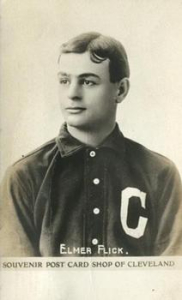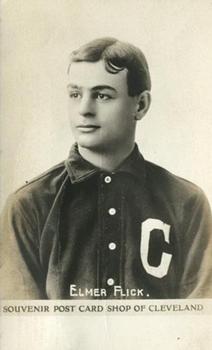July 6, 1902: Elmer Flick’s three triples set American League standard as Cleveland topples Chicago
 Despite Elmer Flick’s accomplishments on the diamond and his selection to the National Baseball Hall of Fame in 1963, he remains relatively obscure to all but the most ardent baseball fans. That is unfortunate; Flick put up outstanding numbers in both the National League and the American League before contracting a “mysterious gastrointestinal illness” that sapped his strength and shortened his career.1
Despite Elmer Flick’s accomplishments on the diamond and his selection to the National Baseball Hall of Fame in 1963, he remains relatively obscure to all but the most ardent baseball fans. That is unfortunate; Flick put up outstanding numbers in both the National League and the American League before contracting a “mysterious gastrointestinal illness” that sapped his strength and shortened his career.1
A great example of Flick’s speed and left-handed power was the July 6, 1902, game between his Cleveland Bronchos2 and the Chicago White Sox. Flick became the first American Leaguer to slam three triples in one game, spurring visiting Cleveland past Chicago, 6-2.
Flick had played the outfield for the NL’s Philadelphia Phillies from 1898 to 1901. He hit .302 as a 22-year-old rookie, adding 86 walks for a .430 on-base percentage that ranked fourth in the league. He suffered no sophomore slump: In 1899 he posted a .342 batting average and knocked in 98 runs. In 1900 Flick was again among the best in the game, grabbing the NL RBI title (110) and finishing second to Honus Wagner in batting average (.367), and slugging percentage (.545); Flick’s 32 doubles tied for third best, and he tied for fourth in triples (16).
When the American League assumed major-league status in 1901 and began signing National League players, Flick’s teammate Nap Lajoie jumped across town to Connie Mack’s Philadelphia Athletics. Flick remained loyal to the Phillies and performed well, hitting .333 with 32 doubles, 17 triples, and 30 stolen bases. But before the 1902 season Flick rejoined Lajoie, signing a two-year contract with the Athletics.
Flick played just 11 games with the pennant-bound Athletics before Mack transferred him to the Cleveland Bronchos on May 8. Flick was placed on a train for Ohio just ahead of service of an injunction prohibiting him to play in Pennsylvania for any team other than the Phillies.3 Lajoie, also entangled in litigation, soon joined Flick in Cleveland, and whenever the Bronchos visited Philadelphia, Flick and Lajoie would remain outside of Pennsylvania.4
For Flick, Cleveland was a perfect fit; he grew up less than 20 miles away in Bedford, Ohio. Flick expressed his hope that hometown friends would watch him play in the American League’s “fast company” for many years to come.5
On a sultry July 6 afternoon at Chicago’s South Side Park, Flick patrolled right field and batted third for the Bronchos as Cleveland met Chicago for the final game of a four-game series. Chicago, the reigning AL champion, had won the first three games of the series, and so far in 1902 the White Sox were dominating the rivalry, winning 10 of 11 from Cleveland by a combined score of 68-26.
The pitching matchup favored another White Sox win. Chicago sent Nixey Callahan to the mound; he sported an 11-2 record and had logged six consecutive wins. Callahan had beaten the Bronchos twice early in the season. His mound opponent, Cleveland’s Earl Moore (6-9), had survived just five innings in an April loss to Chicago, and his last three pitching decisions were losses.
Callahan began the game with two quick outs before Flick came to the plate for the first time. Flick pulled a sizzler past first base and raced to third, arriving safely before the ball was returned to the infield; he had his first triple of the day. Flick scored on a single that Lajoie “pushed out to center as easily as if he had been dealing cards.”6
Flick and Lajoie reprised their roles in the third. Flick hit a rocket high over outfielder Danny Green’s head and off the scoreboard; he scampered to third with his second triple of the day. Another Lajoie single brought Flick home, giving Cleveland a 2-0 lead. Until Flick’s blast, no one had reached the scoreboard with a batted ball,7 and as the Chicago Tribune pointed out, Flick’s long drive “would have been a home run last year [1901], before the scoreboard was moved to its present location.”8
In the fourth inning, Chicago first baseman Frank Isbell “made one of the finest plays of the series,”9 perhaps preventing another Cleveland run. Third baseman Sammy Strang fielded Bob Wood’s grounder near the bag, but fired the ball over Isbell’s head, and to the bleacher fence. Isbell chased down the bounding ball, and “his long and perfect throw to third”10 was just ahead of the sliding Wood, who was tagged out, turning Strang’s error into a defensive highlight.
Tom Daly got Chicago’s first hit in the fifth, but nothing came of it. In the sixth, Cleveland scored its third run when Lajoie doubled and Charlie Hickman singled him home.
Cleveland piled on three more runs in the seventh, all coming after two outs. Moore ignited the outburst with a single, and Harry Bay – described as the fastest man in the AL11 – waited out a walk, putting runners on first and second. Jack McCarthy kept things going, slapping a single that sent Moore home and Bay to third.
With runners at the corners, McCarthy broke for second as Callahan pitched. Catcher Ed McFarland ignored McCarthy and instead fired the ball to third, where the aggressive Bay had wandered too far off base. But McFarland threw wildly, out of the reach of Strang; Bay sprinted home with Cleveland’s fifth run.
Had McFarland thrown on target, Bay would have been the third out. Instead, Flick stepped in against Callahan, ripped his third triple – inserting his name forever in AL annals – and McCarthy jogged home with the Broncho’s sixth and final run.
The Chicago Tribune recognized Flick’s three triples as an “uncommon feat.”12 Still, it was the second three-triple game of Flick’s career. On June 20, 1898, Flick, then a rookie with the Phillies, blasted triples in his first three at-bats at Sportsman’s Park in St. Louis.13 Flick had just become the first player to record three-triple games in both the AL and NL.
Trailing 6-0, the White Sox exploited shoddy defense to score runs in the seventh and ninth, keeping “the perspiring spectators” hopeful of a comeback to the very end.14 Green scored in the seventh when Cleveland third baseman Bill Bradley threw wildly to first on what should have been the final out of the inning.
In the ninth, George Davis safely reached first when first baseman Hickman, a poor fielder,15 bobbled the throw from shortstop John Gochnauer for an error. Davis went to third on a single by Sam Mertes and he scored Chicago’s second run on Isbell’s fly to Flick in right.
With the lead down to four runs, one out, and a runner at first, Moore finished strong. He fanned Daly for the second out, then ended the game when McFarland – Flick’s Philadelphia teammate in his first three-triple game – grounded to shortstop Gochnauer.
Cleveland had a win over its nemesis; Moore kept Chicago down for nine innings by allowing only four hits, and two walks. Cleveland tagged Callahan for 11 hits in the nine innings he worked, and the Chicago hurler walked four. The game was sloppy: Cleveland committed three errors; Chicago four.
Despite the loss, the White Sox remained in first place by four games over second-place Boston. Cleveland occupied the bottom of the AL standings; its 27-38 record placed the Bronchos eighth, 13 games behind first-place Chicago, and 2½ games behind seventh-place Baltimore.
Afterward both teams boarded a train bound for Cleveland to play a series there.16 The Bronchos fared well at home, splitting two with the White Sox, then sweeping three from Detroit.
At season’s end, Chicago (74-60, with four ties) was a disappointing fourth behind first-place Philadelphia, with the St. Louis Browns second and Boston third. Cleveland (69-67, and one tie) finished well, to claim fifth.
Flick hit .297 in his first AL season, and collected 12 triples, good for sixth in the league. He stayed with Cleveland for the remainder of his major-league career. At his peak Flick often appeared on the AL’s leaderboards, topping the league in games played (1906), at-bats (1906), plate appearances (1906), runs (1906), batting (1905), slugging (1905), stolen bases (1904, 1906),17 and triples (1905, 1906, 1907).
Flick’s production declined dramatically after 1907 due to a gastrointestinal ailment resulting in weight loss and acute pain.18 He saw action in just nine games in 1908, and over his final three years, 1908-10, Flick totaled 99 games, hitting .254 in 338 at-bats. Despite this sudden drop-off, Flick compiled a lifetime .313 batting average.
Flick is the only major-league player to register three-triple games in both the nineteenth and twentieth centuries, and as of 2022 he remained the only player to notch a three-triple game in both the NL and AL.
Acknowledgments
This article was fact-checked by Gary Belleville and copy-edited by Len Levin.
Sources
In addition to the sources cited in the Notes, the author consulted Baseball-Reference.com and Retrosheet.org for pertinent information, including the box score. The author also relied on game coverage in the Chicago Tribune, and Cleveland Plain Dealer, and reviewed SABR BioProject biographies for several players involved in the game.
https://www.baseball-reference.com/boxes/CHA/CHA190207060.shtml
https://www.retrosheet.org/boxesetc/1902/B07060CHA1902.htm
Notes
1 Angelo Louisa, “Elmer Flick,” Elmer Flick – Society for American Baseball Research (sabr.org).
2 The author will refer to the team as Bronchos. The team’s official name was Bluebirds, but newspapers referred to it as the Blues or Bronchos.
3 “Elmer Flick a Bluebird,” Cleveland Plain Dealer, May 8, 1902: 8.
4 “Flick to Play This Afternoon,” Cleveland Leader, May 9, 1902: 9.
5 “Flick to Play This Afternoon.”
6 “White Sox Lose to Cleveland,” Chicago Tribune, July 7, 1902: 6.
7 “Notes of the White Sox.” Chicago Tribune, July 7, 1902: 6.
8 “Notes of the White Sox.”
9 “Notes of the White Sox.”
10 “Notes of the White Sox.”
11 John Simpson, “Harry Bay,” Harry Bay – Society for American Baseball Research (sabr.org).
12 “White Sox Lose to Cleveland.”
13 “Happy Days,” Philadelphia Inquirer, June 21, 1898: 4. Only a handful of players have hit three triples in one game on two occasions. The SABR Baseball List & Record Book (New York: Scribner, 2007) lists it as occurring three times before Flick. It occurred at least once afterward. Negro League records are not included in that publication. As more Negro League data is discovered, the list may grow.
14 “White Sox Lose to Cleveland.”
15 John R. Husman, “Charlie Hickman,” Charlie Hickman – Society for American Baseball Research (sabr.org).
16 “Notes of the Game,” Cleveland Plain Dealer, July 7, 1902: 4.
17 Both stolen base titles were shared.
18 Louisa, “Elmer Flick.”
Additional Stats
Cleveland Bronchos 6
Chicago White Sox 2
South Side Park
Chicago, IL
Box Score + PBP:
Corrections? Additions?
If you can help us improve this game story, contact us.


